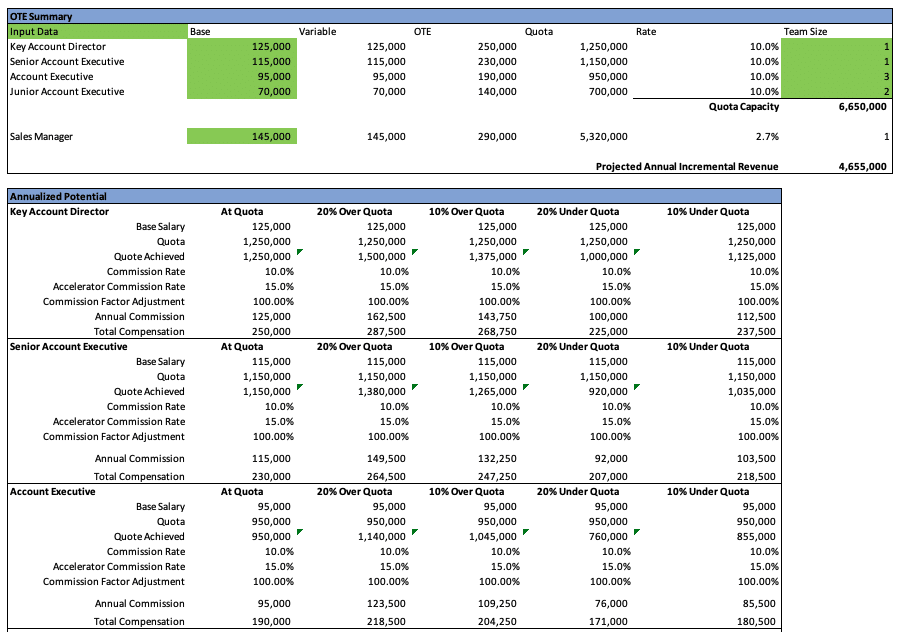A sales compensation plan is a crucial part of your startup’s go-to-market strategy.
I’ve worked in sales for B2B software companies for the past 15 years. At a few of these organizations, the comp plan was so motivating and exciting that it kept me driven throughout each month, each quarter and each year.
I’ve also seen the other side: where you learn what your comp plan is and you’re immediately demotivated by unrealistic targets or seemingly unfair commission structures.
Startup and tech company leaders should understand the essential elements of a good comp plan. We’ve created a startup sales compensation plan template to help you get started.

What Is a Sales Compensation Plan?
A sales compensation plan is a structured program that outlines how a company rewards its sales team based on its ability to achieve certain goals. In most cases, compensation plans include base salary, commission and various bonuses that help drive sales for the company.
Commission and bonus pay are often referred to as variable compensation. An employee’s base salary plus their target variable comp makes up their on-target earnings (OTE). This is the compensation they’d earn if they hit 100% of quota. Actual compensation could be higher or lower than OTE based on the employee’s quota attainment.
Sales compensation plans must include targets that are realistic for the sales team. Ideally, your sales team is motivated enough by the financial incentives of the plan to help increase your revenue.
When constructed well, sales compensation plans will reward your team for their success and encourage them to close more deals. Companies with properly structured incentive programs see employee productivity increase by 44%, according to the Incentive Research Foundation.
Early-stage companies can particularly benefit from a well-engineered comp plan that increases annual recurring revenue (ARR), earned revenue and capital runway.
How to Design the Best Sales Compensation Plan for Your Startup
To design an effective startup sales compensation plan, you’ll need to continuously review your company’s metrics and the performance of your sales team. It’s often helpful to have employees involved from the beginning as you design your plan.
Most companies run their sales compensation plans from Jan. 1 to Dec. 31. It’s great business hygiene to set up a time to review your plan at the end of the year. Analyze performance data and speak with your sales leaders to gain feedback.
Were the variable targets unrealistic? Were they too easy to achieve? Did you prioritize the correct metrics that drove the right types of sales activities? Is the team and comp structure sufficient to drive the company to achieve its growth goals?
While it’s good to monitor your comp plan, resist the temptation to constantly switch your goals and targets. This might confuse your sales team and leave them uncertain about their primary responsibilities.
In some cases, early-stage companies may adjust their plans every six months as they learn what works best.
3 Goals of an Effective Startup Sales Compensation Plan
An effective startup sales compensation plan will achieve three main outcomes:
- Drive business growth to achieve its set goals.
- Motivate the sales team.
- Establish a clear and fair sales foundation.
1. Drive Business Growth
“How does this move the business forward?” Keep that question top of mind as you develop your plan. Every part of your comp plan should align with the strategic goals of your business. If you’re planning to “increase the customer base by X%” or “achieve $Y in ARR, representing Z% growth,” then establish sales targets that enable the company to meet those goals.
2. Motivate the Sales Team
A good comp plan lets everybody win. Successful salespeople will be motivated to increase their personal earnings by driving activities that also increase revenue for the company. When constructing a plan, be sure that sales incentives are aligned to your desired business outcomes.
3. Establish a Clear and Fair Sales Foundation
Gray areas are dangerous in the compensation world. Be sure to clearly outline the base and variable earnings so no one’s confused about where they stand. Also, gut check that you’re adequately rewarding your sales team without pulling too much money out of the company’s pockets. Quota and compensation modeling can help you strike this balance through advanced scenario planning.
How to Create a Sales Compensation Plan
To create an effective sales compensation plan, follow these four steps:
- Establish realistic goals.
- Do your research.
- Communicate with employees.
- Continuously review.
1. Establish Realistic Goals
Before you start assigning numbers, dig deep to understand the main objectives of your comp plan and business goals. Align your sales team’s targets and incentive levers with those goals.
2. Do Your Research
Consider how you’ll reward your employees: lump sum payments, stock options, etc. See if you can find out how competitors are structuring their sales compensation plans. Take parts that you like and blend them with your own ideas. Determine how you’ll reward employees based on performance, merit and tenure.
3. Communicate with Employees
Get your employees’ feedback from the start of the process — and keep them informed. Explain why you’re making certain decisions and how you arrived at the numbers you did. Gaining buy-in will be important to motivation, success and employee retention.
4. Continuously Review
Pay attention to your sales team’s performance on a monthly basis. What’s working? What isn’t? Resist the temptation to constantly tinker with the plan; instead, schedule a holistic review at the end of the year.
SDR or BDR Sales Compensation Plan Example
Sales development representatives (SDRs) and business development representatives (BDRs) typically operate off similar compensation plans.
In mature organizations, these employees are responsible for generating qualified leads and meetings. SDRs and BDRs typically gain commission if they book a meeting with a prospect and pass them off to an account executive (AE) who then closes the deal.
Generally speaking, SDR and BDRs receive variable pay based on how many meetings they book with prospects. It is important to think through what triggers an acceptable meeting. Sometimes it can be when the first meeting takes place, and other times may be when the lead or prospect becomes sales qualified, with certain criteria being hit.
For an opportunity to be considered qualified, oftentimes the BDR will get a general understanding of budget, authority, need and timeline (BANT). You don’t always need all four answers, but there should be some criteria set to determine if it is qualified.
In many cases, 100% of an SDR or BDR’s variable comp is based on the number of meetings they book that meet the criteria. Meetings can also make up slightly less than 100% of their variable compensation, with the rest being tied to revenue closed from their meetings booked.
Here are two possible examples for a BDR compensation plan:
Example A: BDR Commission Based on Meetings Only
Base Salary: $45,000
Variable: $25,000
On-Target Earnings: $70,000
Monthly Quota: 10 qualified opportunities per month
Commission: $208.33 per qualified meeting
Example B: Commission Based on Meetings and Revenue
Base Salary: $45,000
Variable: $25,000
On-Target Earnings: $70,000
Monthly Quota: 10 qualified opportunities per month and $50,000 of revenue per month
Commission: $104.17 per qualified meeting and 2.08% of all revenue generated
If you’re working at an early-stage company, the BDR and account executive roles might be more fluid. Without a fully established sales team, employees of different levels might handle more parts of the sales cycle on their own.
Account Executive Sales Compensation Plan Example
An account executive sales compensation plan is usually tied closely to revenue attainment. Therefore, bigger accounts count for more.
Sales leaders must outline several factors in the AE comp plan, including:
- base salary;
- revenue quota;
- commission rate;
- accelerator commission rate (which incentivizes AEs with a higher commission rate once they exceed their quota);
- projected annual commission; and
- total compensation.
It’s important to plan for different scenarios, such as an account executive exceeding or falling short of their quota.
A comp plan for an account executive could look something like this:

Once you’ve mapped out the comp plan for each individual employee, you’ll put them together to create your overall team’s sales compensation plan. This plan will show each employee’s base salary, projected variable income, quota and commission rate. Adding up each team member’s quota should equal your projected revenue goal for the year.
Company leaders typically forecast revenue at around 80% to 85% of the revenue goal. This weighted quota attainment takes into consideration certain factors that might make it difficult to achieve 100% of revenue goals: ramp-up for new employees, leaves of absence and AEs leaving the company. Here is an example below:

Here’s how a mature organization might structure its team OTE:

Compensation Plan Template
When designed effectively, a comp plan will motivate your sales team and drive your organization toward its goals. Download our startup sales compensation plan template to help you build an effective go-to-market foundation.



